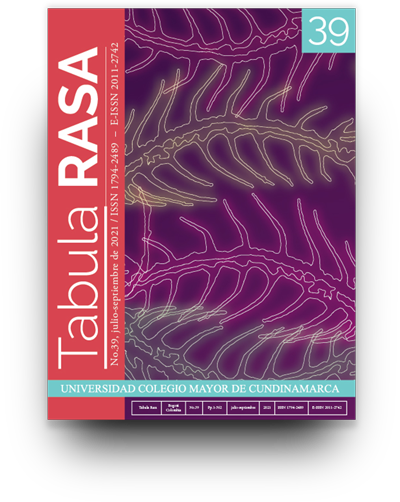Spatial imaginaries and the politics of scale in Colombia.
Imaginarios espaciales y la política de la escala en Colombia.
Show authors biography
This article examines the relationship between spatial imaginaries and the idea of a “politics of scale”. Assuming, conventionally enough, that scale is not an empirical fact but a construction that takes place in specific material conditions, we use examples to sketch out how different imaginaries of scale are deployed in the interests of specific political projects. We suggest that the 1991 constitution represents a kind of “scalar fix” that encouraged a rethinking of scalar relationships, and that this process was marked by the emergence of the importance of territorio. Through examples taken from our ethnographic work in urban areas, we analyse some examples of a pragmatics of scale, the strategic use of scalar imaginaries to further particular political goals.
Article visits 119 | PDF visits 93
Downloads
- Amin, A. (2008). Collective culture and urban public space. City, 12(1), 5-24. https://doi.org/10.1080/13604810801933495
- Brenner, N. (2001). The limits to scale? Methodological reflections on scalar structuration. Progress in Human Geography, 25(4), 591-614. https://doi.org/10.1191%2F030913201682688959
- Echeverri, J. A. (2004). Territorio como cuerpo y territorio como naturaleza: ¿diálogo intercultural? En A. Surrallés & P. García-Hierro (Eds.). Tierra adentro: territorio indígena y percepción de entorno (pp.259-275). Copenhague: IWGIA.
- Gago, V. (2014). La razón neoliberal. Buenos Aires: Tinata Limón.
- Gramsci, A. (2003 [1971]). Selections from the prison notebooks. London: Lawrence and Wishart.
- Griffin, A. (2019). Negociando el derecho a la ciudad: grafiti en Bogotá. Revista Austral de Ciencias Sociales, 37, 209-229. https://doi.org/10.4206/rev.austral.cienc.soc.2019.n37-12
- Jaramillo Marín, J., Parrado Pardo, É. & Louidor, W. E. (2019). Prácticas de memoria en defensa de la vida y el territorio en Buenaventura, Colombia (1960-2018). Íconos 64, 111-136. https://doi.org/10.19053/20275137.n21.2020.9599
- Lefebvre, H. (1996). Writings on cities. Oxford, UK: Blackwell.
- Leitner, H., Sheppard, E. & Sziarto, K. M. (2008). The spatialities of contentious politics. Transactions of the Institute of British Geographers, 33(2), 157-172. https://citeseerx.ist.psu.edu/viewdoc/download?doi=10.1.1.726.3464&rep=rep1&type=pdf
- Lopes de Souza, M. (2016). Lessons from praxis: Autonomy and spatiality in contemporary Latin American social movements, Antípode, 48(5), 1292-1316. https://doi.org/10.1111/anti.12210
- Marston, S. A., Jones, J. P. III & Woodward, K. (2005). Human geography without scale. Transactions of the Institute of British Geographers, 30(4), 416-432.
- Mejía, O. (2006). Poder constituyente, crisis política y autoritarismo en Colombia. Revista Jurídicas, 3(2), 47-82. http://juridicas.ucaldas.edu.co/downloads/juridicas3-2_3.pdf
- Mejía, O. (2002). La Constitución de 1991 como proyecto inacabado. El Otro Derecho, 28, 147-169.
- Moore, A. (2008). Rethinking scale as a geographical category: From analysis to practice. Progress in Human Geography, 32(2), 203-225. https://doi.org/10.1177%2F0309132507087647
- Morgan, N. (2019). The antinomies of identity politics. En P. Wade, J. Scorer & I. Aguiló (Eds.), Cultures of anti-racism in latin america and the caribbean. London: Institute of Latin American Studies.
- Múnera, A. (2005). Fronteras imaginadas. Bogotá: Planeta.
- Paasi, A. (2004). Region and place: Regional identity in question. Progress in Human Geography, 28(4), 536-546. https://doi.org/10.1191%2F0309132504ph502pr
- Rolston, B. & Ospina, S. (2017). Picturing peace: Murals and memory in Colombia. Race & Class, 58(3), 23-45. https://doi.org/10.1177%2F0306396816663387
- Santos, M. (2017). Milton Santos: A pioneer in critical geography from the Global South. Mosbach: Springer.
- Saquet, M. A. (2018). A perspective of counter-hegemonic analysis and territorial transformation. Geographica Helvetica, 73, 347-355. https://dx.doi.org/10.5194/gh-73-347-2018
- Schwarz, A. & Streule, M. (2017). A transposition of territory: Decolonized perspectives in current urban research. International Journal of Urban and Regional Research, 40(5), 1000-1016. https://ideas.repec.org/a/bla/ijurrs/v40y2016i5p1000-1016.html
- Serje, M. (2005). El revés de la nación. Bogotá: Uniandes.
- Sharp, D. (2018). Rethinking Transitional Justice. Cambridge: CUP.
- Smith, N. (1995). Remaking scale: competition and cooperation in prenational and postnational Europe. En H. Eskelinen & F. Snickars (Eds.). Competitive European Peripheries (pp.59–74). Berlin: Springer Verlag.
- Smith, R. G. (2003). World city actor-networks. Progress in Human Geography, 27, 25-44.
- Tickner, A. B. (2008). Aquí en el Ghetto: Hip-hop in Colombia, Cuba, and Mexico. Latin American Politics and Society, 50(3), 121-146. https://doi.org/10.1111/j.1548-2456.2008.00024.x
- Yates, J. (2012). Uneven interventions and the scalar politics of governing livelihood adaptation in rural Nepal. Global Environmental Change, 22, 537-546. https://doi.org/10.1016/j.gloenvcha.2012.01.007




